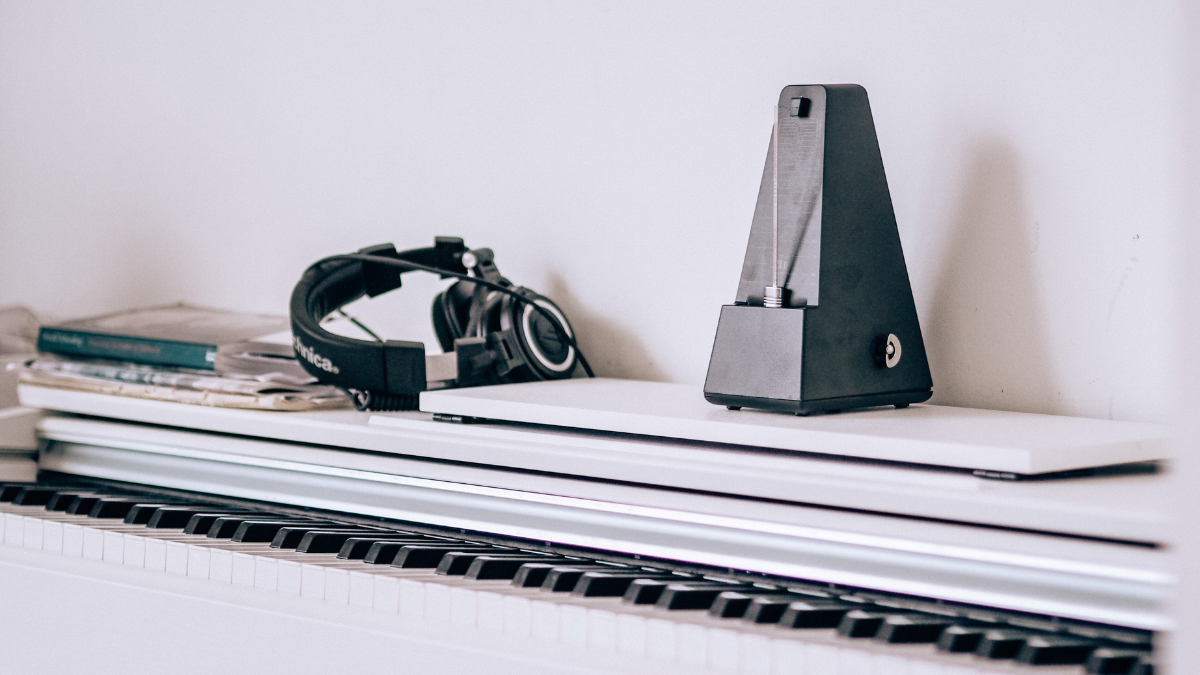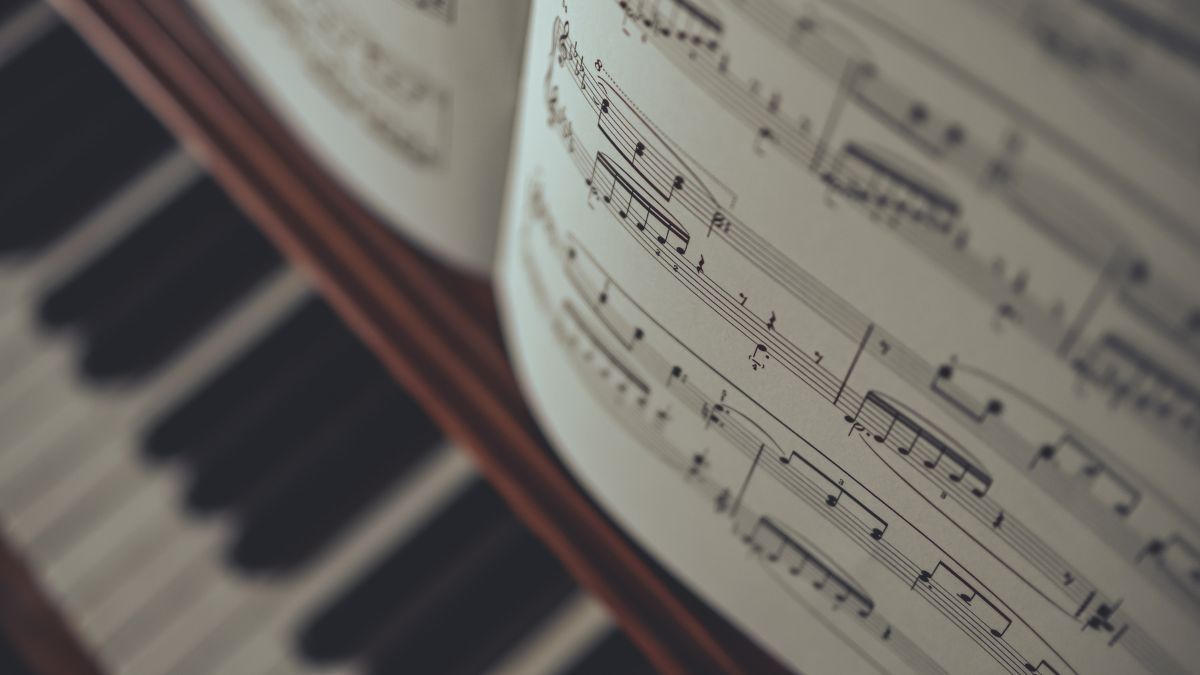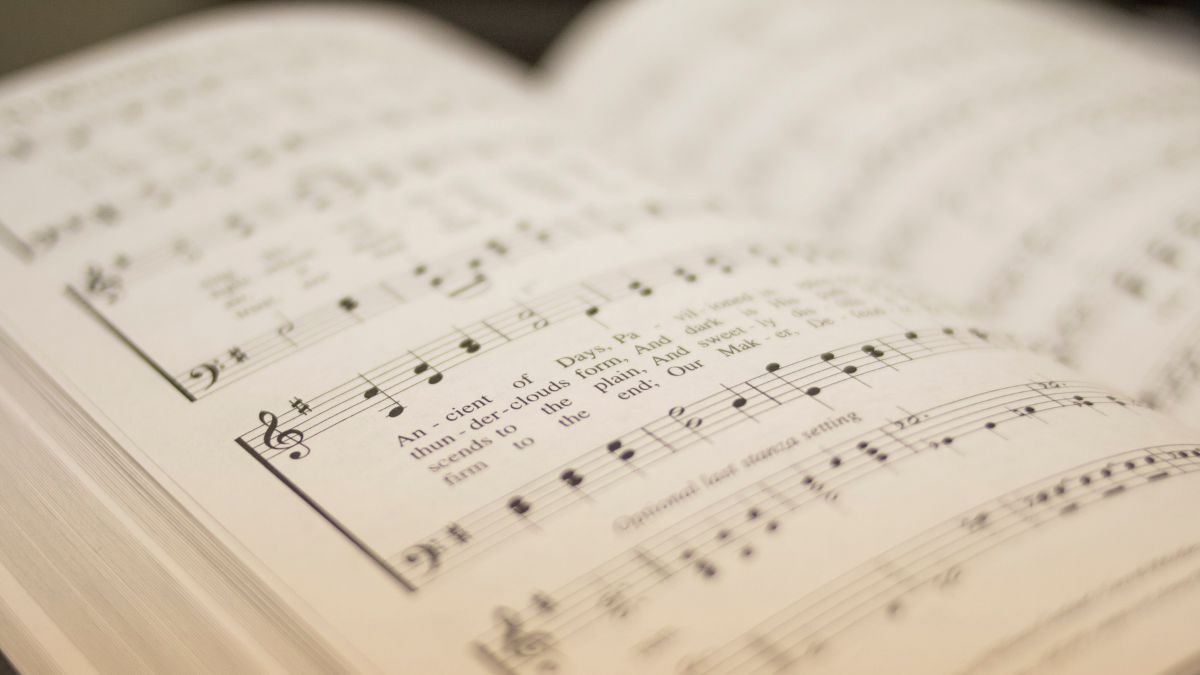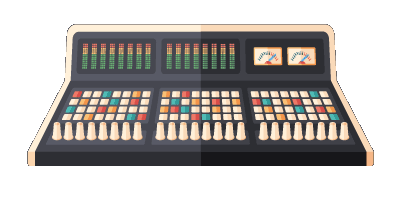What Is Ear Training? The Ultimate Guide To Training Your Ears Like A Professional

Ear training is no different than weight-lifting or going through a circuit at the actual gym. The ears (and, by extension, the brain) are muscles. And like any other muscle, it can be trained over time to become stronger, sharper, and more powerful.
What is Ear Training?
Ear training is the practice of training our “inner ear” to identify, analyze and reproduce musical sounds without an instrument or written implements, using only our hearing.
it helps to enrich and accelerate all aspects of our musical learning, and musical ventures. Being able to quickly recognize pitches, scales, keys, and chords, while also having the ability to reproduce the sounds and music you hear inside your head is indispensable to any musician, past and present.
This process, known as “audition”, is the ability to transmute sound as thought into sound as well, sound.
Why Is Ear Training Important?
As musicians and composers, we often invest in new gear, software, and content, failing to realize that the greatest asset we have isn't tangible.
1. It makes you a better musician
All musicians have an 'inner ear', the ability to generate ideas in the brain. Far fewer have the ability to readily translate those ideas into living music. You don't need to be a scholar to be a quality musician, or a great artist, but having greater control of the science behind sound gives you the ability to stretch, manipulate and transform music with greater freedom and intention.
2. It's a new language
Ear training gives you the vocabulary to communicate better with other musicians, and describe ideas and concepts you already use. Music is something we all love and connect with, and speaking its language at the highest level is almost motivation enough to start ear training today.
3. It increases your value
The next time you land the gig, you'll be more equipped to not only communicate with your fellow musicians and the crew, but to help problem-solve, make adjustments and pick up bonus points (and checks) for harmonizing, re-writing, and arranging parts, on the fly, all of which increase your demand, your pay grade, and your human asset capital.
4. It speeds up your workflow
You'd be hard-pressed to find a songwriter or producer that hasn't lost inspiration while fiddling around with guitars, midi controllers, Flex-Time, or tuning plug-ins, desperately trying to express that idea in their head.
ideas can come and go in the blink of an eye. Your job as a creative is to serve the art. Don't let a lack of ear training run away with your next hit.
5. Learn to hear with your ears, not your eye
Ear training lifts the notes off the page, and gifts you widely applicable knowledge of harmony, intervallic relationships and rhythm. It breathes freedom into your playing, practice and composition, helps you to break out of patterns on your instrument, and makes music more accessible, whether or not you're with a manuscript or instrument.
6. It's fun
Music theory is awesome, and your ears are incredible pieces of machinery. Ear training is like driving a really nice car (and just as cool to flex at parties).
Learn music because you love it. Invest in your ears because you value music and what it means to you. Learn more about the things in life that bring you joy. Music is a gift and sharpening the tools you were given to appreciate it is a reward in and of itself.
Two Types of Ear Training
There are two different types of ear training, musical ear training, and audio ear training. Here’s what that means, broken down.
Musical ear training is as old as modern music itself. Given early music’s emphasis on chorale and voice, the natural evolution of solfeggio (and sight-singing, or prima vista) over many centuries has bred a rich history of audiation and musical ear training exercises used by musicians the world around. These exercises focus on musical fundamentals like scales, chords, intervals and rhythms. Musical ear training exercises train us to hear, identify and reproduce musical sounds and parts by ear or by sight. The ability to sing music off of a page, discern between different musical intervals without reference, or identify scales and chord types by ear are all examples of skills that belong to musical ear training.
Audio ear training, however, is a more recent invention, growing alongside the progression and development of new and exciting recording technologies in the industrial and now digital ages. Audio ear training focuses on training our ears to more minutely understand and differentiate between actual recorded or produced sound, or “sonic palette”. Things like different frequencies, processor settings (such as equalization or EQ, compression, delay, and distortion), and layering of polyphonic or complex rhythms as in modern beat-making.
This is a skill prized by writers, producers, recording engineers, mixers and mastering engineers, and now more and more utilized by bedroom producers.
Being able to reproduce and mold sound to quickly bring to life the ideas inside our head is another important skill for most every modern musician, so a healthy balance of both musical ear training and audio ear training is paramount.
What Are The Benefits Of Ear Training For Musicians?
A solid foundation in ear training, both musical and audiological, provides myriad benefits to all who create, share and work inside the music industry. If you’re still wondering how ear training might provide benefits inside your particular vocation, here are some ways in which both types of ear training might improve your musical experience, and enrich your musical journey top to bottom.
For players:
As an instrumentalist, being able to quickly glance over a piece of written music without the aid of your instrument is an asset to your musicality and employability. With ear training, you’ll also become a better improviser, more easily being able to connect the dots between idea and execution on your instrument of choice. When working in a collaborative environment, your ability to copy parts, pieces or musical passages suggested by another or altered on the fly just by hearing them played in real time will enliven your creativity, technical ability, and contributions as a writer and band member.
For composers/writers:
As a writer/composer, ear training is almost tantamount to your very being. Survivability as a composer/writer comes down to your ability to lift ideas from the brain and put them down on the page (or into the DAW). Without this ability, we’re totally lost.
Good musical ear training will help you compose and write quickly, knowing which chords will sound good together, even without the aid of a keyboard or computer. It will also empower you to work faster, and get more reward for your hard work. You see, for any artistic endeavor, the reward must be greater than the work you put in, or else your creative process will become exhausting, dull and wholly unmotivating. This frustration is the number one reason people give up and abandon projects prematurely, or leave their field altogether. Ear training helps to bridge the gap when it comes to ideating and re-creating the ideas we have inside, greatly reducing the effort and amount of labor required to compose, write and share our songs, vision and emotions.
For songwriters, having the vocabulary to communicate with other professionals and collaborators, while also having the musical tools to facilitate the success of your own writing is going to heighten your ability to express yourself, which is, at the end of the day, the most important element to musical study.
For producers:
Studying both musical and audio ear training are a prerequisite to experiencing creative success. The job title of “producer” has evolved rapidly since its introduction into recorded music 80 odd years ago. While at first producers facilitated and sort of “directed” recording sessions with live musicians, the role began to evolve in the 1960s, when producers like the Beatles’, Sir George Martin, and Brian Jones of the Rolling Stones began using the recording studio as an instrument unto itself.
It was at this juncture that the term “producer” came to mean something totally different. A technician AND artist, who creates rather than captures a musical performance. This vocation has evolved overtime to the type of producer we know today, someone who both creates and facilitates the creation and capture of musical ideas, and uses technology to arrange those ideas into a finished song or production.
When it comes to musical ear training, producers benefit immensely from having a solid foundation in intervals, scales, chords and especially rhythms. Being able to record melodies and chord progressions quickly with MIDI is a huge asset, especially when many producers still struggle to understand theory without the aid of things like MIDI “chord packs” or pre-recorded samples from a website like Splice or LANDR.
Also being able to program rhythms quickly, again without the aid of loops or samples is another asset, to breed originality and breadth in the work.
Audio ear training is equally important to producers, who are more alchemists of sound than anything else. Understanding where different instruments sit in a mix, the frequencies required to alter the timbre or quality of a part, or the right settings to quickly dial in a plug-in or production tool are all skills that will not only expedite a producer’s workflow but also emphasis creation and musicality rather than button mashing guesswork and tweaky, technical time-wasting.
For audio professionals:
While both musical ear training and audio ear training will benefit all music types, audio ear training is paramount for audio professionals to have a solid understanding of the very basis of their work. Being able to analyze and alter the sound by ear is the name of the game when it comes to mixing and mastering fields, as well as live sound.
While some technology now provides a visual aid to envisioning sound, the best engineers out there have ears of gold, ears that they have trained acutely and over time.
If you have any interest in mixing, mastering or producing live concerts, make sure to spend as much time as you can on our old brother site, SoundGym.
Best Ear Training Exercises
Our number one tip to improve your ear training is to start now. You don’t have to develop a crazy or perfectly regimented practice routine overnight, or do it perfectly for that matter; just start!
Just 10 minutes a day, every day, will reap more benefits than trying to do a two hours session once every other week to the point of fatigue. Our daily workout routines on ToneGym break ear training into manageable chunks that help you get better each and every day.
Interval Ear Training
Interval ear training is the technique of identifying or singing different musical intervals by ear. An interval is defined as the space between two tones or notes. Each one has a unique sound, created by the distance between notes. Because each interval has its own characteristic sound, one can easily learn to tell them apart, and identify them by ear.
Many musicians find it helpful to begin with references from famous and recognizable songs or tunes that contain each interval. For example, the interval of an octave can be heard as the first two notes in “Somewhere Over the Rainbow”. The perfect fifth on the other hand, forms the first two notes of the melody from the opening theme of “Star Wars”.
These references make it easy to sing these intervals, as one can just hum the first few notes of the popular tune. Over time, these sounds will become rote, and you will be able to identify them out of context as well. There are only 14 intervals in Western music, so memorizing them isn’t that daunting. It may feel that way at first, but with repeated practice and exposure, you’ll be able to pick them out in no time.
The best place to start training intervals is with Intervalis on ToneGym.
Chord Ear Training
A chord by definition, is a combination of three or more notes, sounded simultaneously. Chords contain combinations of intervals to produce different sounds, known as chord qualities. Learning to identify chords quickly is helpful in composition, writing, and learning songs by ear. It’s probably the most important skill to learn other than sight-reading for session players and musicians.
Some chord types you probably already know or have heard of are major, minor, suspended, diminished, augmented and dominant.
There are many other types of chords, extensions and inversions, all of which can be trained using our Chordelius and Inversionist tools.
Rhythmic Ear Training
Rhythmic ear training is an everyday excursion for percussionists and drummers, but is often overlooked by the rest. Rhythmic ear training is incredibly important and should be trained separately from harmonic and melodic ear training.
The goal of rhythmic ear training is to develop a better sense of timing, build a more detailed roadmap to music in all forms, and also facilitate in quickly producing, recreating, and processing beats, grooves, and patterns, both recorded and in live musical situations.
Scoot into Rhythmania to start building up your rhythmic ear training chops, and challenge yourself to our BeatRace beat-making challenge on SoundGym once you’re ready!
Scale Ear Training
Given that chords are the building blocks of songs, and chords come from scales, being able to identify scales and scale patterns by ear is important.
Scales in Western music are often formed from seven notes (although some scales contain five notes). These notes are taken from the 12 note chromatic musical scale. Different scales contain notes placed in different orders. The distances between notes creates that scale’s unique tonal quality.
There are two basic qualities of scales, major and minor. From there, different permutations can produce even more specific and colorful sounds, like Dorian, Lydian, Melodic Minor and Altered.
Our Scale Spy will start with just the basics, to help you learn to differentiate between major and minor tonalities, before branching out into more complex and challenging scale sets and modes.
Chord Progression Ear Training
Once you have a basic grasp of intervals, scales, and chords, you can pull from all of these skills to help you in identifying entire chord progressions.
A chord progression is when two or more chords are ordered and played in sequence, usually repeated over some set period of musical time or bars. Most chord progressions contain three to four chords, with five and six chord progressions being common in more complex pop, RnB and soul music. Jazz musicians often play pieces that contain over a dozen chords, with some chords being borrowed from different keys entirely.
To begin identifying the basic three and four chord progressions, you’ll want to head over to the Route VI game on ToneGym. This game will aid you in identifying chord progressions from the start on. Starting with just a few chords, the game will increase in difficulty until you are faced with more complex progressions including inverted progressions and progressions with borrowed chords.
An important tool tip in being able to identify chord progressions is to firmly establish the tonic “1” chord. Once you embody the tonic, you can use that as a point of reference to understand which chords follow in the progression. The more difficult part of this exercise is being able to identify the chords in the middle of the progression, as they drift further away from home base. One way to overcome this is to continue referencing the tonic root and comparing that note to the root note of the other chords. By isolating just the root of the chord, and treating it like a basic interval identification, you can at least get the relative position and scale degree which the chord is built on. From there, you can apply your existing knowledge of major and minor tonality to determine the chord type (say, VI or vi).
Route VI actually allows you to isolate the chord’s bass note a finite number of times to aid in your quest, as a helpful hint. You don’t want to lean on this too heavily, and eventually won’t need it at all. But it’s a good tool to ensure that you’re practicing properly early on.
Melodic Ear Training
Learning to analyze melodies by ear is more important than ever as a music maker. Melodic ear training is an extension of intervallic and scalular ear training. To readily pick out a melody at first listen is the benefit of melodic ear training. This is especially useful for writers and producers when writing “top-line” or vocal melodies for songs and tracks. Melodic ear training can also help us to isolate and differentiate between a song's melody and its harmony.
As mentioned earlier, melodic ear training requires a solid fundamental grasp of intervals and scale training.
One of the keys to melodic ear training is identifying the melody’s starting pitch. Melodies often do not start on the tonic, this would make music incredibly boring. For example: the chorus melody in Taylor Swift’s “Shake It Off” begins on the 2nd scale degree, “A”. The chorus also begins on the ii chord, “A minor”.
You can also put your melodic ear training skills to the test with our Melody Jay game!
Functional Ear Training
Speaking of ii chords and 2nd scale degrees, this feels like an opportune time to discuss functional ear training…
There is a bit of debate about this term, “functional ear training”, but the general consensus is that functional ear training is the practice of training and applying your ear muscles within context. For example, understanding and being able to identify not only the chord as minor or the interval of, say, the major 2nd scale degree… but actually being able to place it into the piece of music within context and understand its “function” in the piece, passage or progression, constitutes “functional” training.
This is a skill that will likely develop out of progress in all of the above, but you may actually be doing it already…
Soon after you begin your ear training journey, you may start to recognize and pull patterns out of songs you stream or hear in TV shows and YouTube videos. Taking the next step to understanding functionality is just a hop away. For example, you may hear the sound of a minor 4 chord. If you are eventually able to identify the following chord, and connect the two into a cadence or chord movement, you’re on your way to functionally training your ears.
Ear training is being able to listen and identify, “that is a minor chord”.
Functional ear training is being able to listen further and identify, “that is the iv minor chord, and the next chord is the tonic. Therefore, this song has a minor plagal cadence.”
Ear training is being able to listen and identify, “that chorus starts on a minor chord”.
Functional ear training is being able to listen further and identify, “that chorus starts on a minor chord. The song is in a major key one whole step away, so that minor chord is the ii chord in the key.”
Frequency Ear Training
As a producer or engineer, learning to identify different frequency ranges is an indispensable asset when it comes to dialing in the right sounds for your production and projects.
These five frequency ranges are low, low-mids, midrange, upper midrange and highs.
Breaking frequencies down into five broad categories works for many, but producers who excel are able to split hairs. SoundGym’s Peak Master will help you narrow down these specific frequencies and get ahead when it comes to building soft-synth sounds, EQ’ing a vocalist or rapper, and mixing your demos, productions and bedroom tracks more efficiently.
Dynamic Ear Training
Traditionally, dynamics in music refer to the fortitude, volume, and aggression with which a particular musical passage or piece is played.
Since the advent of recording, both analog and digital, dynamics now encompass processing that affects the amplitude of a signal or soundwave. Some of these effects are compression, distortion, and limiting.
Learning to find the right settings for these plug-ins and units can be challenging, with many instrumentalists, producers and engineers reverting to presets or total guesswork. However, this too is a skill that can be developed with proper training.
Check out the Compressionist game on SoundGym to put your skills to the test and start learning!
How to Practice Ear Training?
To apply the skills you’ve learned in ear training to the music you love, try sitting down and actively, as opposed to passively, listening to it.
Listen through the piece once, without judgment or analysis, let it wash over your ears and brain.
Now listen again, this time choose something specific to listen for
- The placement of the kick drum (which beats?)
- The chord progression in the chorus (what are the chord types? Does it start on the tonic or another chord in the key?)
- Which scale or key forms the song’s melody? Is it major or minor? Does it have modal qualities? Which note in the scale does the melody begin on?
Repeat this process several times, listening for something new each time. You don’t have to get it perfect, and you can feel free to check your work on the piano or guitar.
One important thing to discuss before you hit the gym again is that practice does not make perfect. Perfect practice makes perfect. Bad practice will actually hinder your ability to learn and function as a musician. It’s more important to take things slow, use your resources and get it right from the start, however slow or clunky, than it is to guess, rush, act impulsively and try to bulldoze your way through exercises just to pass by the skin of your teeth.
Our suggestion is to cast pride aside, don’t be afraid to reference your instrument and check your work if needed, and return to fundamentals when you feel yourself getting sloppy or consistently making many or the same, mistakes over and over again.
Lastly, you’ll want to let your ears rest. Like any other skill or exercise that requires hyper-focus, concerted effort, and attention, ear training can feel exhausting after a while. Try to give your ears time to recover by not listening to music entirely.
Many professional musicians don’t listen to music in the car or on the train, after coming back from a long day’s rehearsal or recording session. It’s nice to clear your head, reset and come back ready to apply yourself like never before.
Some suggestions are to exercise (literally), take a nap, read a book, go for a walk (and listen to nature instead) or cook a meal. These things engage other parts of the brain, allowing the ears to repair and the brain to detach from the activity.
We are always excited to see you taking the next steps in your musical journey! To learn new skills, challenge yourself and train your ears to level up your skillset and ambitions as creators, beatmakers, producers, writers, and shredders.
Remember to be consistent, practice every day, and never stop finding joy in making, listening to, and nurturing a deeper understanding of the music that moves us.



Comments:
Aug 30, 2023
Login to comment on this post